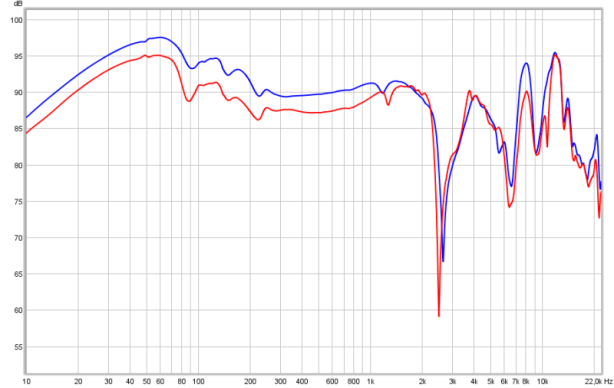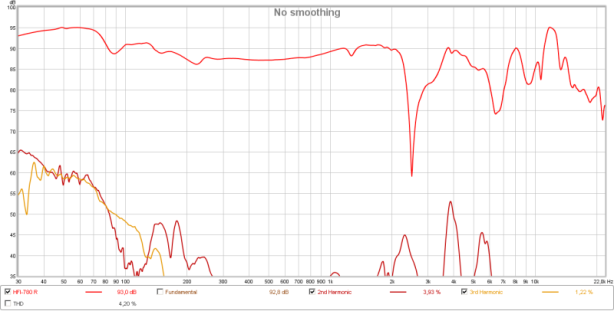Ultrasone
NO SMOOTHING is applied to the shown plots. Most measurement sites have some smoothing applied which ‘irons flat’ sharp peaks and ‘wiggles’. I do not use smoothing because some info about sound quality is lost when plots are smoothed.
Aside from a small correction of the microphone itself also some correction in the lowest frequencies is applied to the plots to compensate for the perceived loss of bass when using headphones. This is described HERE in more detail.
A ‘horizontal‘ frequency response curve on the shown frequency response plots on this website thus indicates a perceived ‘flat’ tonal signature.
ALL measurements are made with a good SEAL on a flatbed measurement rig.
The shape of your head, bone structure, pad size, pad ‘softness, (compliance), hair or no hair and or wearing glasses may (drastically) change the frequency response of some headphones, so… your personal experience may differ substantially from these plots.
Frequency response (tonal balance) is the most sound-determining aspect of headphones. A horizontal line shows audible neutral response in the plots on this website. Deviations in different severities at different frequency bands have an effect on the sound character.
The bigger the deviation the stronger the effect.
Below an aid to help determining the sound character of headphones with relation to the frequency response.


Ultrasone HFI-780
Thanks to Nicola for sending it in to be measured. These look nice in reality (the pics don’t do it justice). The aluminum cups look really neat.
But… no matter how good headphones look, in the end it is all about the sound.
This is where these headphones are a real let down. Having heard quite a lot of headphones I can honestly say these sound ‘worse’ than many mid-fi or even cheap headphones. The bass is ‘disconnected’ (this even aside from the L-R differences). The (upper) mids have a sharp ‘edge’ around it. Nice when listening to certain trumpets perhaps but voices get a raw ‘edge‘. They also can sound somewhat muffled at the same time lacking real detail. The treble is well …rough… as in not smooth, not clearly defined. In some jazz recordings it isn’t as obvious though and the cymbals get some extra ‘metal shimmer’ in that case. The lower midrange actually isn’t really that bad and can be considered neutral but the upper midrange ‘edge/distortion’ draws it down to low-fi.
All in all there is too much ‘wrong‘ with this headphone for listening relaxed and for longer than 5 minutes and really enjoy a plethora of different genres and recordings. The very few things it doesn’t do that bad do NOT outweigh the negative aspects at all.
Below the frequency plot of the Ultrasone HFI-780. Left, Right
The level difference between the left and right channel puzzled me the first time I measured it and thought something went wrong and didn’t get a good seal. Alas a few measurements later the difference remained. Both channels are measured on the same mic.
This seems to be something in the driver or cup. It is quiet audible as well. The bass draws strangely to the left where the upper mids suggest to you it should be in ‘the middle’ somewhere.
People that love deep bass, but not too overpowering (as some other Ultrasones) and don’t care about nice smooth upper mids and highs may like the ‘subtle’ bass boost. If you loose the seal just slightly (sunglasses, hair) you also loose that bass boost by the way.
It’s as if flat headphone is used where someone sets the 60Hz slider to +6dB when a good seal is present.
The ‘S-Logic’ blabla nonsense has never worked for me. It is said to do something for the soundstage but as I cannot hear the soundstage people talk about (I seem to be soundstage and DAC-deaf) so cannot confirm the claim.
S-Logic is the part where 2/3 of the driver is blocked with a piece of metal and only 1/3 of the driver gets to emit sound into the bottom part of the cup (where the earcanal entrance is). I don’t know (yet) if this is causing the jagged and ‘rough’ treble which on average is slightly below neutral, I may investigate this.
Below the CSD of the HFI-780. Left and Right are superimposed in this plot. The treble region consists of series of (short lived) resonances at various frequencies. Not an example of how HF response should be IF you are looking for smooth treble.
Below the distortion plots of the HFI-780, the right channel. The 2nd and 3rd harmonics are both present below 100Hz. A lower (3rd harm.) distortion would have been pleasant. The rise between 150 and 200Hz are likely to be more degrading to the sound. Not to mention the spikes at 2.5kHz, 4kHz and 5.5kHz which also does not help with getting clean upper mids and may be perceived as some ‘shrillness’ as it pops out above 1% there.
In my opinion these should not be considered hi-fi but rather below mid-fi or even lo-fi. The clamping force is on the high side of comfortable and the pleather pads get sticky and sweaty after some time.
Modifications to this headphone are discussed HERE.



